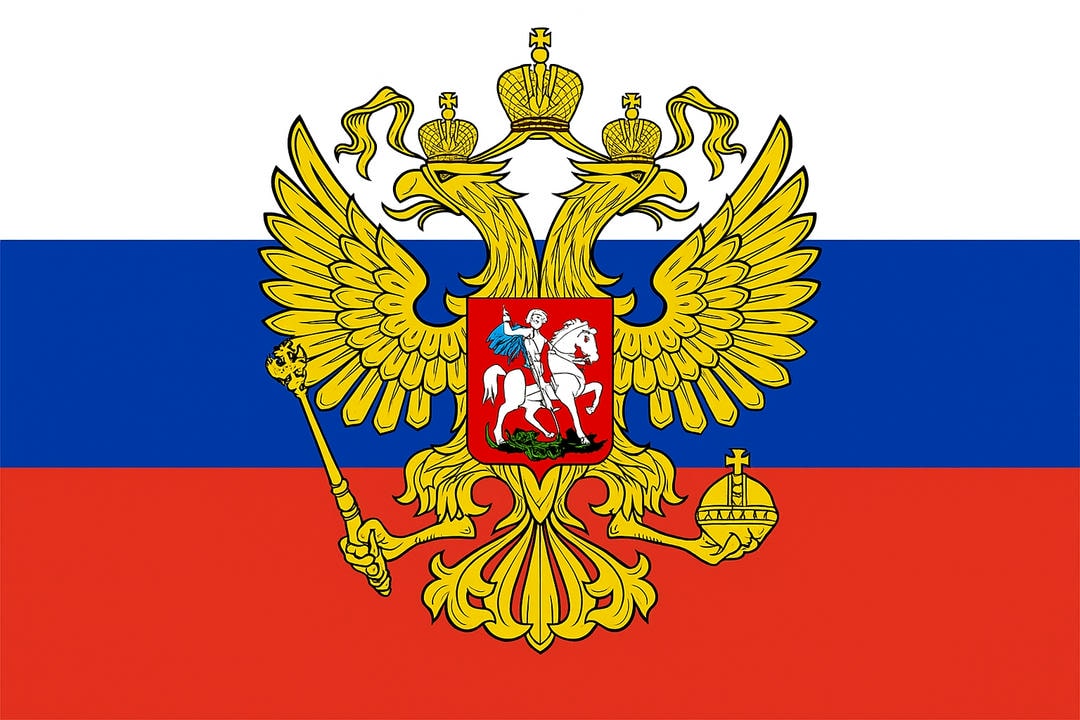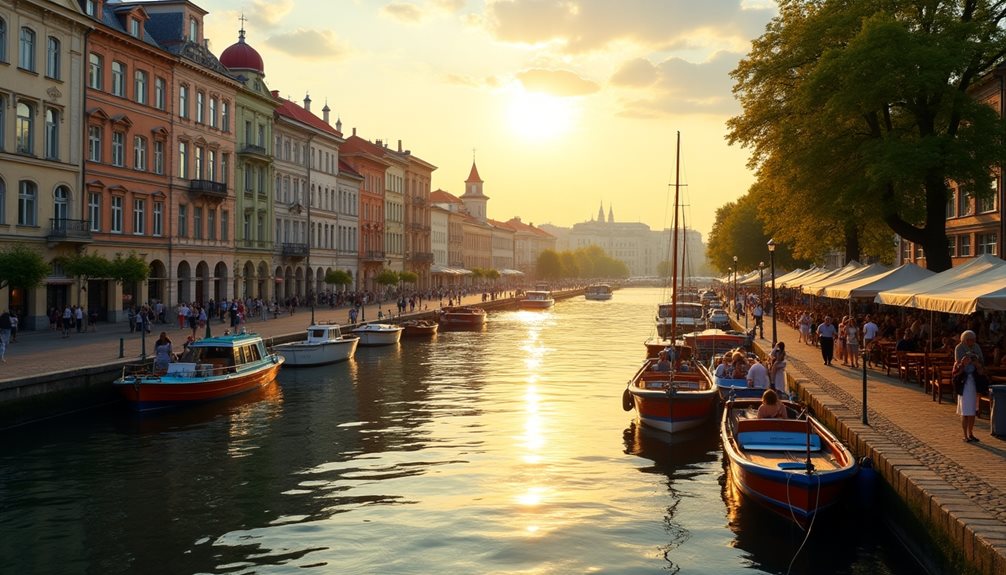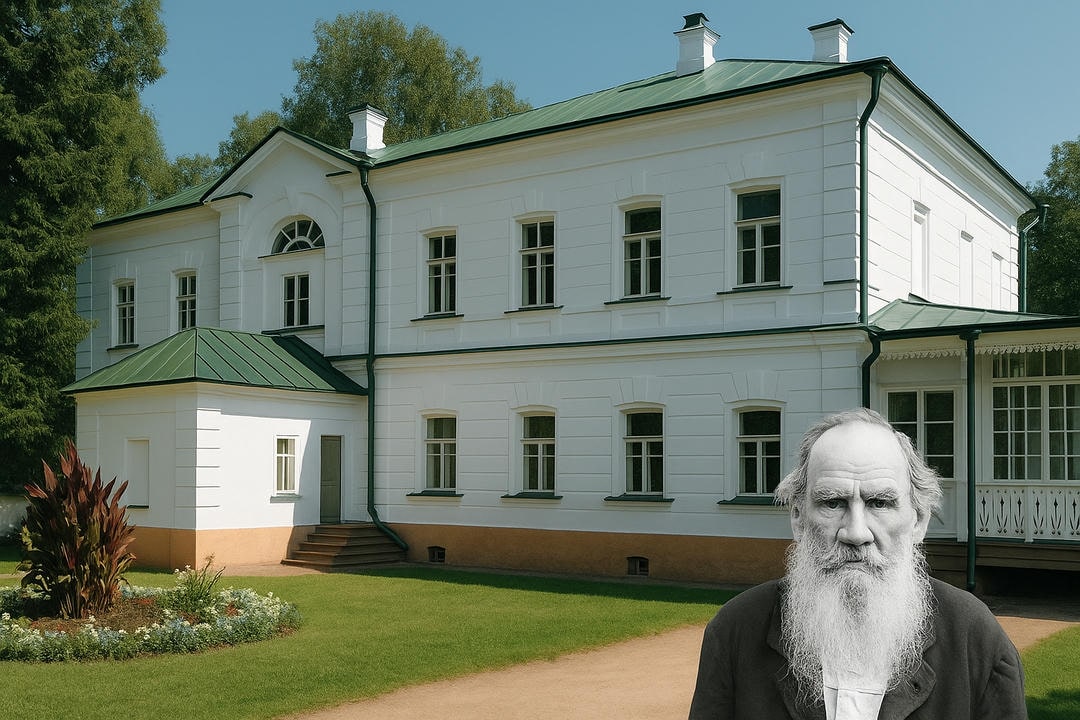When you explore the evolution of Russian music, you’ll find a fascinating blend of genres that reflect the country’s rich history and cultural diversity. Starting with the deep-rooted traditions of folk music, featuring iconic instruments like the balalaika, you’ll see how these sounds tell stories of communal life. Moving into the classical realm, you’ll encounter the profound works of composers like Tchaikovsky, who brought emotional depth and Western influences into the mix. As you transition to contemporary times, Russian pop music showcases a unique fusion of global trends and local heritage. Curious about how these genres intersect and evolve over time?
Early Beginnings
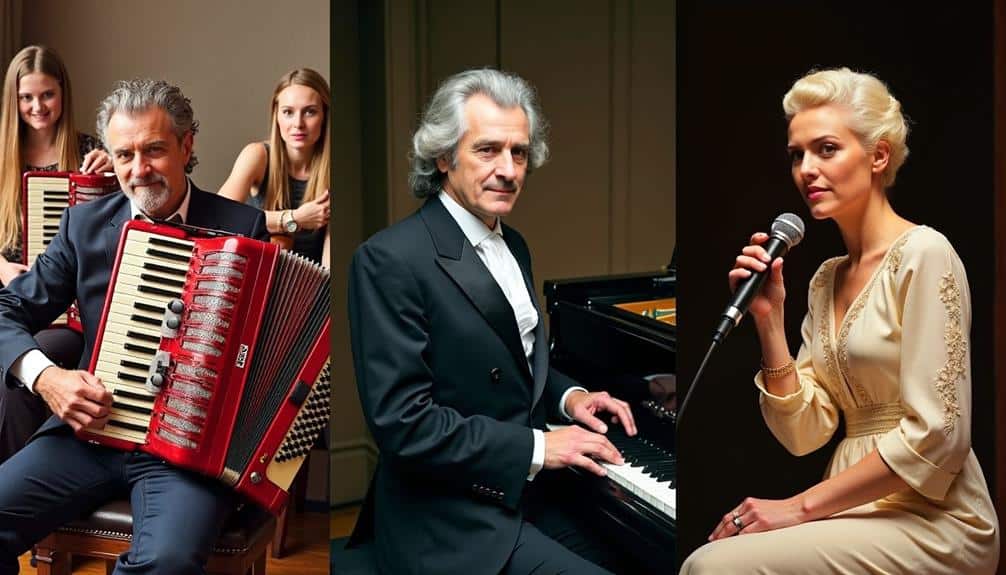
When you delve into the early beginnings of Russian music, you uncover a rich tapestry woven from centuries of cultural and historical influences. The roots of Russian music stretch back to the times when ancient instruments like the gusli and zhaleika played pivotal roles in the sonic landscape. These instruments, with their distinct sounds, were integral in shaping early musical traditions.
Understanding the early stages involves exploring the myriad cultural influences that converged in Russia. From Byzantine chants brought by Christian missionaries to the Mongol and Tatar incursions, each wave of cultural exchange left an indelible mark. The gusli, a type of plucked string instrument, not only entertained but also served as a medium for storytelling and preserving history.
You’ll find that these ancient instruments were more than mere tools for music; they were vessels of cultural identity. The zhaleika, a traditional wind instrument, played a crucial role in communal activities and rituals.
As you examine these early beginnings, it becomes clear how deeply intertwined Russian music is with its historical and cultural milieu. Recognizing these foundational elements allows you to appreciate the complex evolution of Russian music.
Traditional Folk Music
As you move from the early beginnings of Russian music, rich with ancient instruments and diverse cultural influences, you’ll encounter the vibrant world of traditional folk music. This genre serves as a cornerstone of Russia’s cultural identity, weaving together regional styles and storytelling themes that have been passed down through generations.
You’ll notice traditional instruments like the balalaika and gusli, each adding unique textures to the music. These instruments often accompany songs that narrate oral histories, ensuring cultural preservation.
Different regions in Russia boast distinct styles, from the lyrical ballads of the North to the rhythmic, danceable tunes of the South.
Folk music isn’t just about listening; it’s a participatory experience deeply embedded in communal gatherings and seasonal celebrations. Imagine villagers coming together during harvest festivals, singing and dancing to the rhythmic beats that mark the passage of time and seasons.
Dance traditions like the khorovod, a circle dance, bring communities closer, creating a shared cultural memory.
In essence, traditional Russian folk music is a living archive, preserving the nation’s rich heritage while fostering a sense of community. By engaging with this musical form, you’re not just listening but becoming a part of an enduring cultural legacy.
Rise of Classical Music
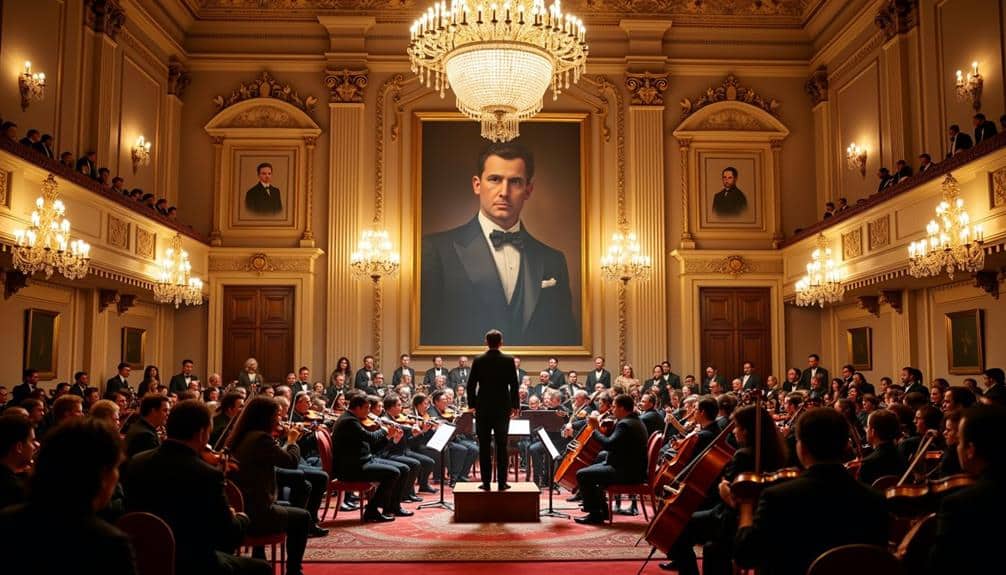
Transitioning from the communal landscapes of folk traditions, the rise of classical music in Russia marks a significant evolution in the country’s artistic expression.
You’ll notice that this period saw the introduction of Western musical instruments like the piano and violin, which began to replace traditional folk instruments. These changes didn’t happen in isolation; they were driven by significant cultural exchanges with Western Europe. Russian composers started to study abroad, bringing back new techniques and styles that were then integrated into native compositions.
Within this context, you can see how Russian classical music started to develop a distinct identity. Composers like Mikhail Glinka played a pivotal role in this transformation. Glinka, often referred to as the father of Russian classical music, combined Western structures with Russian folk melodies, creating a hybrid that resonated deeply with the Russian soul.
The rise of conservatories in cities like St. Petersburg and Moscow further solidified this shift, offering formal training and fostering a new generation of composers.
Understanding this period is crucial because it laid the groundwork for the unique Russian sound that would later influence global classical music. It’s a story of adaptation, innovation, and cultural synthesis, setting the stage for future musical achievements.
Romantic Era Influence
You can trace the profound influence of the Romantic Era on Russian music by examining how composers of this period embraced emotional depth and individuality.
Romantic composers like Pyotr Ilyich Tchaikovsky and Mikhail Glinka began to infuse their works with rich, expressive melodies and complex harmonies, reflecting the broader European Romantic movement. This period marked a significant shift from the structured forms of the Classical era to more personal, evocative compositions.
Cultural exchange played a crucial role in this transformation. Russian composers were increasingly exposed to Western European musical trends through travel and study. They incorporated elements of German, French, and Italian music, blending them with Russian folk traditions to create a unique, hybrid sound.
For example, Glinka’s operas combined Italian bel canto with Russian folk themes, forging a new, distinctly Russian operatic style.
The Romantic Era also saw the rise of programmatic music, where compositions told a story or painted a picture. Tchaikovsky’s symphonies and ballets, such as “Swan Lake” and “The Nutcracker,” are prime examples of this trend, using music to convey deep emotional narratives.
Through these developments, the Romantic Era profoundly shaped the evolution of Russian music.
Soviet Era Changes
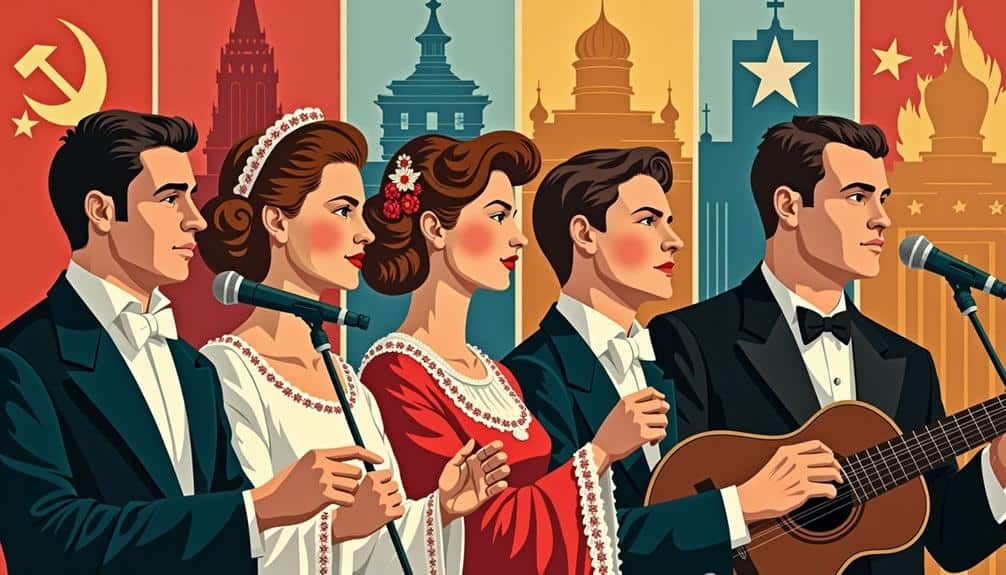
The profound emotionality and individuality of the Romantic Era set the stage for the dramatic shifts in Russian music during the Soviet Era. Under Soviet control, music became a powerful tool for Soviet propaganda, reflecting the state’s ideological influence.
You’d find that cultural censorship was rampant, dictating what composers and musicians could create and perform. State control was pervasive, but this didn’t stifle all creativity. Instead, it pushed some artists toward musical experimentation within the constraints imposed.
Despite heavy censorship, an underground scene flourished, where musicians could explore themes and styles that state broadcasters wouldn’t permit. This underground movement became a critical space for artistic expression, offering a counter-narrative to the official Soviet doctrine.
Folk revival also played a significant role during this period, as traditional melodies were repurposed to align with Soviet values, yet retained cultural authenticity.
The ideological influence of the state wasn’t entirely negative; it inadvertently fostered unique innovations. By understanding these shifts, you can appreciate how Soviet musicians navigated a complex landscape of repression and creativity, balancing state expectations with the ever-present desire for individual expression and cultural continuity.
Post-Soviet Transformation
When the Soviet Union collapsed in 1991, it marked a seismic shift in the Russian music landscape, opening the floodgates for diverse genres and unprecedented artistic freedom. You could see the immediate impact on the music scene, where artists no longer faced state censorship. This newfound freedom fueled a creative renaissance, leading to a rich tapestry of sounds and styles.
The post-Soviet identity played a crucial role in this transformation. Musicians began to explore themes of national heritage, blending traditional Russian folk elements with contemporary genres like rock, jazz, and electronic music. This cultural fusion created a unique sonic environment that reflected both the struggles and hopes of a nation in transition.
You’ll notice that the Western influence became more pronounced during this period. Artists eagerly adopted and adapted global musical trends, integrating them into their work. This cross-pollination didn’t just enrich Russian music; it also helped Russian artists gain international recognition.
In essence, the post-Soviet transformation was a period of immense growth and diversification for Russian music. It enabled artists to redefine their cultural identity, blending old traditions with new influences, thereby laying the groundwork for a dynamic and varied musical landscape.
Modern Pop Culture
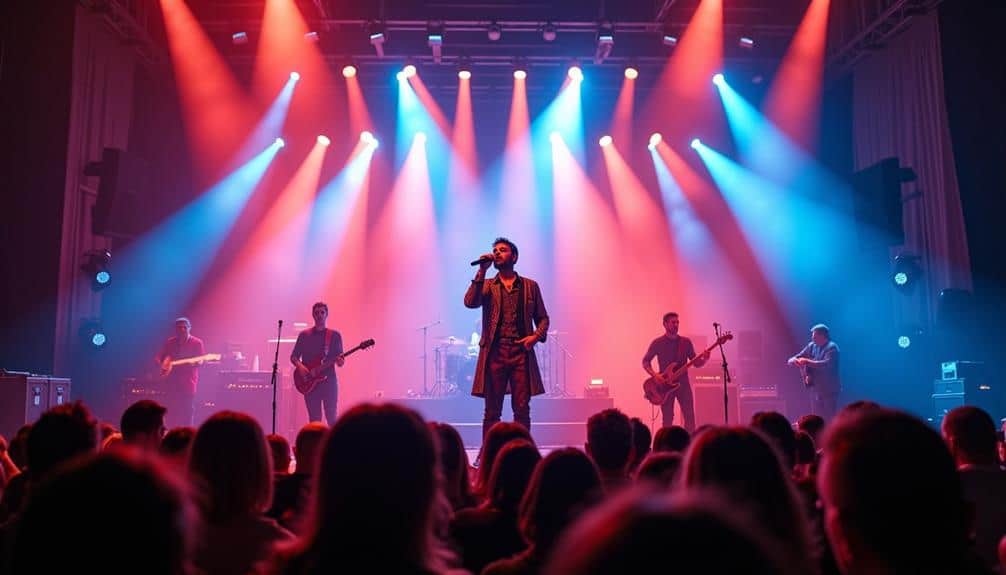
Modern pop culture in Russia has evolved into a vibrant and multifaceted phenomenon, reflecting both the nation’s historical context and its contemporary aspirations. You can see this evolution clearly in the bustling music festivals that dot the urban landscape, serving as a melting pot for various genres and styles.
These festivals are more than just events; they’re a testament to the dynamic youth culture that thrives in cities like Moscow and St. Petersburg.
Urban influences play a significant role in shaping modern Russian pop music. Street art, fashion, and the fast-paced city life all contribute to the sound and style of today’s artists.
Digital platforms like VKontakte and YouTube have democratized content creation, enabling emerging talents to reach massive audiences without traditional gatekeepers.
Youth culture is at the forefront of this transformation. Young Russians aren’t just passive consumers; they actively engage with and shape the music scene.
They use digital platforms to discover new acts, share their favorites, and even collaborate with artists. This interconnectedness fosters a sense of community and keeps the scene fresh and innovative, reflecting a blend of local heritage and global trends.
Global Impact
Russian pop culture’s evolution isn’t confined to its borders; it’s making waves globally. Through cultural exchange and international collaborations, Russian artists are influencing and being influenced by the global music scene. This musical diplomacy has resulted in genre fusion, where traditional Russian sounds blend seamlessly with contemporary trends like electronic dance music and hip-hop.
You can see these cross-cultural influences at global festivals, where Russian musicians share stages with international stars, promoting a rich tapestry of world music. Events like Eurovision have showcased Russian talent to a broader audience, breaking down cultural barriers and fostering a mutual appreciation.
International collaborations have become a cornerstone for Russian artists. Think of how partnerships with Western musicians have led to innovative new sounds, enriching both parties’ musical repertoires. This fusion isn’t just about sound; it’s about sharing stories, emotions, and experiences that resonate universally.
In the sphere of contemporary trends, Russian artists aren’t just participants but pioneers. They’re setting the pace in areas like digital music distribution and social media engagement, proving that Russian music isn’t just a local phenomenon but a global force.

